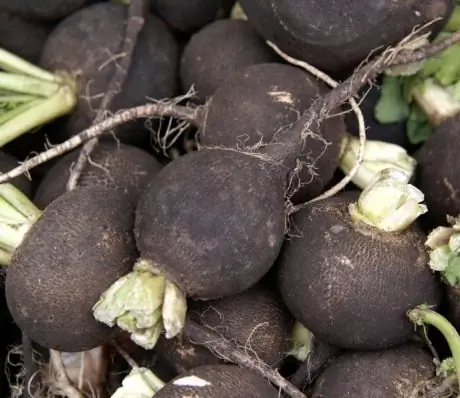- Author Rachel Wainwright [email protected].
- Public 2023-12-15 07:39.
- Last modified 2025-11-02 20:14.
Black radish
Radish is an edible plant belonging to the cabbage family that grows wild in Central Asia and as a cultivated plant in Europe and America. The fruits of this vegetable have an oblong or rounded shape, white with a yellowish tinge and a tart sweetish taste.
The ratio of BJU in the product

Source: depositphotos.com How to burn 36 kcal?
| Walking | 9 minutes |
| Jogging | 4 minutes |
| Swimming | 3 min. |
| A bike | 5 minutes. |
| Aerobics | 7 minutes |
| Household chores | 12 minutes |
Biological features and distribution
Radish is a plant with branchy stems and yellowish petals. The ovary is located on the stalk, and the roots are spherical and end with a long nose. The skin of the root vegetable can be greenish, pink, purple and black.
Radish was first grown on the territory of Ancient Egypt and became the main ingredient for vegetable oil. Then the vegetable was brought to Greece, and later spread throughout Europe and Asia.
The ancient Greeks and Egyptians appreciated the great benefits of radish for treating colds and strengthening the body. And also often used radish for cough and inflammation of the respiratory tract.
There are several main types of radish:
- White is a hybrid and has a juicy tart taste;
- Primorskaya grows on the coast of the Atlantic Ocean and on the shores of the Black Sea;
- Wild (field) is a weed that spreads among crops in Europe and North America;
- Sowing (garden) has many subspecies, including radish, black radish, lobo and daikon.
Useful properties of radish
Radish contains essential oils, vitamins of group B, C and A, enzymes, organic matter, glucosides, sugar and amino acids. The beneficial properties of the radish are manifested due to its composition, which is rich in phytoncides, calcium, phosphorus, magnesium, iron, fiber and sulfur-containing substances.
The roots of this vegetable contain a large amount of carbohydrates and mineral salts, which are necessary to strengthen the protective properties of the human body.
The radish has antimicrobial and bactericidal properties that help fight viral infections. Cough radish is especially effective as an expectorant. Honey is added to its juice and taken daily. Apply radish for coughs of various types - bronchitis, reflux, spastic cough.
Grated radish is used to treat sciatica, and a raw plant with oil promotes the digestive system, improves appetite, and removes excess fluid from the body. The glucosides and essential oils in the vegetable help dissolve bladder stones.
The benefits of radish are high in the treatment of liver diseases, strengthening hair and nails, as well as in restoring the body after an inflammatory process. Radish juice has medicinal properties, contains rafanol and butyl mustard oil. Compresses with the juice of this vegetable and the addition of vodka are applied to sore joints.
As a result of international scientific research, the benefits of radish for people with atherosclerosis, gout, diseases of the digestive and genitourinary systems have been identified.
For flu and acute respiratory viral infections, it is recommended to use grated black radish with honey, and freshly prepared juice is rubbed into the skin for myositis, sprains and neuritis.
Calorie content of radish
In terms of calorie content, radish is similar to other vegetables and is a low-calorie dietary product.
The calorie content of the radish is 36 kcal, and it also contains 1 g of proteins and 7 g of carbohydrates.
Eating radish
Radish root vegetables can be eaten raw, fried, boiled and steamed, as well as juice and gruel can be prepared from them. Root vegetables are used to make salads, okroshka and snacks, and foliage is added to soups and meat dishes.
Spicy varieties of radish in Europe are used to prepare savory salads with the addition of vegetable oil, vinegar, spices and black rye bread. Vitamin salads from the root vegetables of this vegetable are beneficial for the immune system.
Popular in France are radish stew and soup with fried vegetable slices. In Russia, the traditional radish dish was turya, which is a cold salty soup with crackers.

Contraindications
Radish is contraindicated in severe diseases of the digestive system, as well as after operations on the digestive tract.
This vegetable should not be consumed if you are prone to allergic reactions to essential oils.
People with kidney, liver, pancreas, bowel, and heart disease should not consume fresh radish. It is better to boil or steam a vegetable, and also add oil, carrots or apples to it.
YouTube video related to the article:
Found a mistake in the text? Select it and press Ctrl + Enter.






